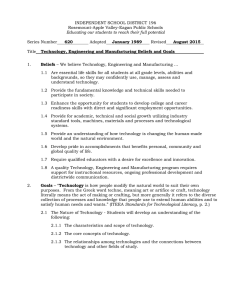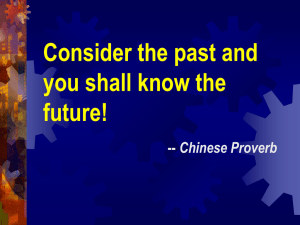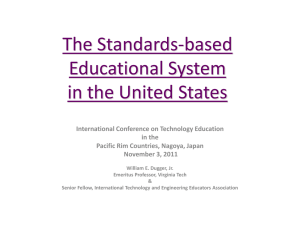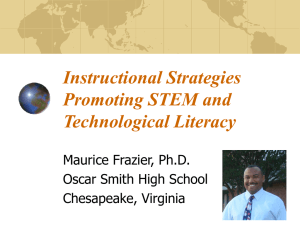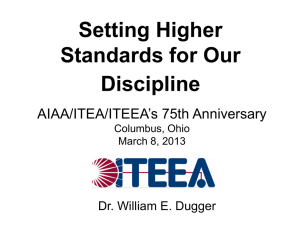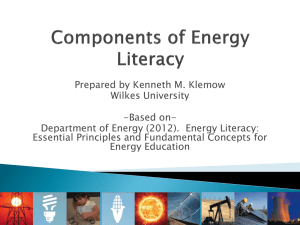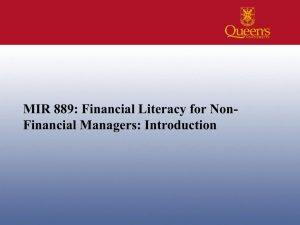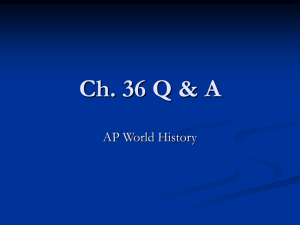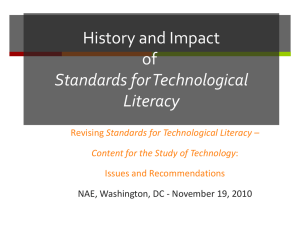PalestineKeynote2012 - International Technology and
advertisement
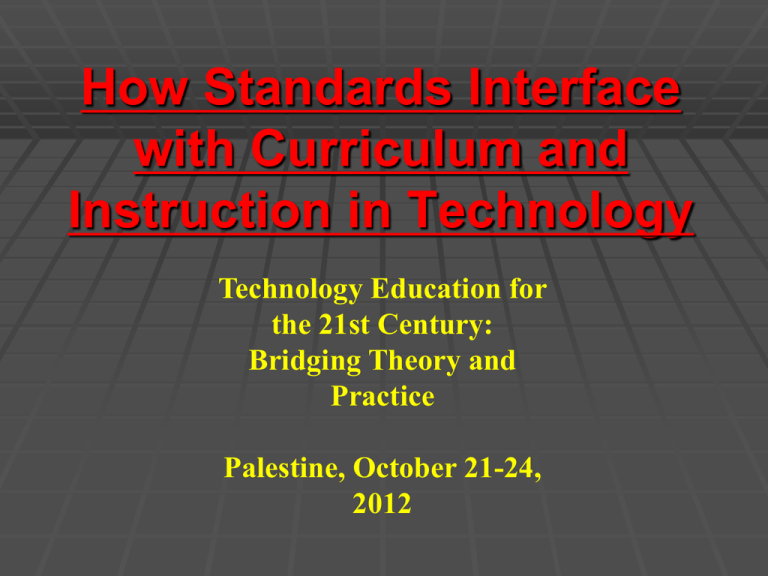
How Standards Interface with Curriculum and Instruction in Technology Technology Education for the 21st Century: Bridging Theory and Practice Palestine, October 21-24, 2012 The Study of Technology Many countries in the world have been and are now implementing the study of technology. Palestine should be congratulated along with its three universities and the World Bank for their important work in technology education. In the United States as well as in other countries, there is confusion about the term “technology.” In 2001 and 2004, The International Technology Education Association (ITEA) conducted polls which were done by the Gallup Organization on how people think about technology. In both polls, a majority of the respondents (62% in 2004 and 59% in 2001) responded that science and technology are basically one and the same thing. When asked how important it is for high school students to understand the relationship between science and technology, 98% of the the participants stated that they thought that this was “very or somewhat important”. Most of those who participated (68% in 2004 & 67% in 2001) view technology very narrowly as being computers, electronics, and the internet. There was near total consensus (98% in 2004 & 97% in 2001) in the public sampled that schools should include the study of technology in the curriculum. Please let me say that the United States does not have all the answers or solutions about technology education. We have been working on it but we are by no means finished. The Constitution of the United States grants the Federal Government no authority over Education, the 10th Amendment applies: "The powers not delegated to the United States by the Constitution, nor prohibited by it to the States, are reserved to the States respectively, or to the people." What is Science? What is Technology? Science seeks to understand the natural world. National Science Education Standards, National Research Council, 1996. What is Technology? It is the innovation, change, or modification of the natural environment in order to satisfy perceived human wants and needs. (Standards for Technological Literacy, ITEA, 2000) The goal of technology is to make modifications in the world to meet human needs. (National Science Education Standards, NRC, 1996) What is Technology ? (Continued) In the broadest sense, technology extends our abilities to change the world: to cut, shape, or put together materials; to move things from one place to another; to reach farther with our hands, voices, and senses. (Benchmarks for Science Literacy, AAAS, 1993) Technology is the process by which humans modify nature to meet their needs and wants. (Technically Speaking: Why All Americans Need to Know More About Technology, NAE/NRC, 2002) Needs and Wants A human need, or, more accurately, the object of a human need is something which a human being must have in order to live a good life. A want, or more accurately, the object of a want, is something which one desires to have, whether or not one needs it. Human Technological Needs and Wants Health and Safety Food and Fiber Energy Communication Information Mobility Products Shelter and Comfort Science vs. Technology Deals with the natural Deals with how humans world. Is very concerned with what is (exists) in the natural world. (i.e.: Biology, Chemistry, Physics, Astronomy, Geology, etc.) modify, change, alter, or control the natural world. Is very concerned with what can or should be designed, made, or developed from natural world materials and substances to satisfy human needs and wants Science vs. Technology (Continued) Is concerned with processes that seek out the meaning of the natural world by “inquiring”, “discovering what is”, “exploring”, and using “the Scientific Method”. Is concerned with such processes that we use to alter/change the natural world such as “Invention”, Innovation”, Practical Problem Solving, and Design. While technology and science have a common denominator being the natural world, they are similar yet very different. Technology is not any more “applied science” than science is “applied technology”. Blending of Technology and Science Bio-Technology Nano-Technology Agri-Science Applied Optics Biological Engineering And many others Technology Education This is the school subject specifically designed to teach children about the broad field of technology. Technology Education (the study of technology) should NOT be confused with Information Technology or Educational (or instructional) Technology! So what is “Technological Literacy?” Technological literacy is the ability to use, manage, evaluate, and understand technology. Technology Literacy for All: A Rationale and Study for the Study of Technology (2006) Who is a technologically literate person? One that understands: What technology is How technology is created How the use of technology shapes society and in turn, How society shapes the development of technology A person who is comfortable with and objective about the use of technology – neither scared of it nor infatuated with it. Technological literacy involves: Much more than a knowledge about computers and digital electronics. Gaining a degree of knowledge about the nature, behavior, power, and consequences of technology from a real world perspective. There is a growing movement in some countries to teach the integrative subjects of Science, Technology, Engineering, and Mathematics (STEM). So how do we educate our people to be technologically literate? ? ? ? ? ? ? ? What Content should be taught in the study of technology that will provide technological literacy for all students? Standards for Technological Literacy (STL)(ITEA, 2000,2002/2007) presents the content for what every student should know and be able to do in order to be technologically literate. www.iteea.org What is a standard? A standard is a written statement or statements about what is valued that can be used for making a judgment of quality. (ITEA/ITEEA, Standards for Technological Literacy, 2000,2002,2007) Standards are NOT a Curriculum! The curriculum is a plan for delivering the content in the Standards each day in the classroom and laboratory. Curriculum describes and specifies the methods, structure, organization, balance, and presentation of the content. (Adapted from STL, ITEEA 2000, 2002, 2006). Types of Standards ➽Content Standards: Subject–matter descriptions of what students should know and be able to do. ➽Performance Standards: Concrete examples and explicit definitions of what students have to know and be able to do to demonstrate proficiency in the skills and knowledge outlined by the content standards (more like passing scores on a test). Why are Standards Important?* ◉ Standards become the basis for the way teachers are trained, what they teach and what is on standardized tests that students take. ◉ Also, standards are guideposts for schools. Teachers, parents and students use them as a tool to focus on what students are expected to learn in each grade and each subject. *GreatSchools, Inc. <http://www.greatschools.org> Standards STL Standards are twenty written statements about what is valued that can be used for making a judgment of quality. Standards represent fundamental concepts. The goal is to meet all of the standards. STL Standards were written around five major organizers or categories. Nature of Technology Students will develop an understanding of the characteristics and scope of technology. Students will develop an understanding of the core concepts of technology. Students will develop an understanding of the relationships among technologies and the connection between technology and other fields of study. Technology and Society Students will develop an understanding of the cultural, social, economic, and political effects of technology. Students will develop an understanding of the effects of technology on the environment. Students will develop an understanding of the role of society in the development and use of technology. Students will develop an understanding of the influence of technology on history. Design Students will develop an understanding of the attributes of design. Students will develop an understanding of engineering design. Students will develop an understanding of the role of troubleshooting, research and development, invention and innovation, and experimentation in problem solving. Abilities for a Technological World Students will develop the abilities to apply the design process. Students will develop the abilities to use and maintain technological products and systems. Students will develop the abilities to assess the impact of products and systems. The Designed World Students will develop an understanding of and be able to select and use medical technologies. Students will develop an understanding of and be able to select and use agricultural and related biotechnologies. Students will develop an understanding of and be able to select and use energy and power technologies. The Designed World (Cont.) Students will develop an understanding of and be able to select and use information and communication technologies. Students will develop an understanding of and be able to select and use transportation technologies. The Designed World (Cont.) Students will develop an understanding of and be able to select and use manufacturing technologies. Students will develop an understanding of and be able to select and use construction technologies. Benchmarks Benchmarks in STL are specific requirements or enablers for each grade level (K-2, 3-5, 6-8, & 9-12) that identify what needs to be done in order to meet a given standard. A Sample Standard & Benchmark Standard 11: Students will develop abilities to apply a design process. Grades K-2 (Ages 5-7) Benchmark in Standard 11: Build or construct an object using a design process. International Translations of STL into German, Japanese, Chinese, Finnish, and Estonian (The Eastonian and Finnish Translations are not shown) Advancing Excellence in Technological Literacy: Student Assessment, Professional Development, and Program Standards Student Assessment Standards for Technological Literacy Student Assessment: Is defined as the systematic, multistep process of collecting evidence on student learning, understanding, and abilities and using that information to inform instruction and provide feedback to the learner, thereby enhancing student learning. Professional Development Standards for Technological Literacy Professional Development: Is defined as a continuous process of lifelong learning and growth that begins early in life, continues through the undergraduate, pre-service experience, and extends through the in-service years. Program Standards for Technological Literacy Program: Is defined as everything that affects student learning, including content, professional development, curricula, instruction, student assessment, and the learning environment implemented across grade levels. The system-wide technology program manages the study of technology in technology laboratory-classrooms as well as in other content area classrooms. In conclusion… The power and promise of technology can be further enhanced through the study of technology to assure that all people are technologically literate in the future. A copy of this presentation can be downloaded by going to: http://www.iteea.org/Resources/ PressRoom/PalestineKeynote2012.ppt Thank You! William E. Dugger, Jr. Senior Fellow and Former Director Technology for All Americans Project International Technology and Engineering Educators Association wdugger@iteea.org & Emeritus Professor of Technology Education Virginia Tech dugger@vt.edu
